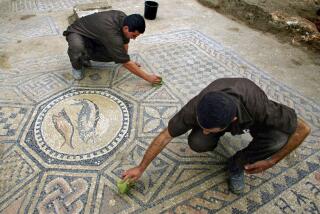A Look at the Past With the Tools of the Future
- Share via
If you’ve ever wanted to watch archeologists in action but haven’t been able to visit--or visit at the right time--this month brings an unusual opportunity.
Beginning Friday or Saturday, a team from Johns Hopkins University exploring the temple of the goddess Mut in Luxor, Egypt, will post a daily account of their activities, with pictures, on the Internet.
As they explore the temple, part of the massive Temple of Karnak dating from at least 3,600 years ago, archeologist Betsy Bryan and her team will provide a running commentary on their work, giving viewers a unique insight into the archeological process.
The postings are a particularly vivid example of how scientists can use the Internet to make the process of exploration accessible to a broader swath of the public. Researchers hope the public exposure will give people a better idea of how archeology is done and, perhaps, generate additional support for the work.
“We are trying to give people a sense of what happens in the field, to use it as a teaching tool,” Bryan said. The site makes information about new discoveries available immediately. It also gives the families of the 12 students working at the site a chance to see them in action.
Bryan’s team began posting the data this year during the January digging season and, despite a lack of publicity, attracted more than 17,000 visitors to their Web site at www.jhuedu/neareast/egypttoday.html. They hope to garner more hits this year.
Producing the site does entail some extra work. Photographer Jay VanRensselaer carries a digital camera with him in addition to the camera he normally uses to document the dig.
“At the end of the day, Jay and I gathered in the lounge of this little hotel where we stayed, sat at a table, looked at the images and chose which ones were most representative of the work and the people,” Bryan said.
“Then I would sit and write captions for them. By the time we were done, about 8 p.m., Jay would walk across the street to an Internet cafe and send them to [his wife,] Macie Hall, [at Hopkins], who would place them on the Web site.
“It was actually pretty low-tech, but it worked well. It adds two to three hours to the end of the day, but we felt it was worth it.”
*
Goal Is to Reconstruct
Original 1600 BC Temple
The site where they are documenting the work has been, until recently, one of the least-studied major archeological sites in Egypt. Mut (pronounced “moot”) means mother. The goddess Mut was considered to be the wife of Amun, the great national god of ancient Egypt whose temple at Karnak along the lower Nile River is the largest religious complex in Egypt and one of the largest in the world.
The temple of Mut is south of the central complex of Karnak, surrounded on three sides by a sacred lake. The temples are connected by two paved alleys flanked by rows of ram-headed sphinxes. Amun’s statue was brought to the Temple of Mut for rituals commemorating the birth of their son Khonsu, the moon god, who also has a temple at the site.
“Mut is fascinating but not altogether a very nice goddess,” Bryan said. Her major role is as a mother figure, “but she has another side, a lion-headed god who can visit quite horrible things on the population if she is not happy, such as pestilence and illness. It was important for her to have her own temple to be sure she was kind and generous.”
Mut’s temple was originally built about 1600 BC, then rebuilt about 700 BC. The stones used in the original temple were salvaged, turned around so that any writing on them was hidden, and reused in the newer version. One of the goals of the current team is to find the hidden writing and determine how the stones originally were put together and what was on the exterior of the older temple.
“Our aim is to try and reconstruct how the temple looked in its earliest form,” Bryan said.
Bryan is following in the footsteps of two British women, Margaret Benson and Janet Gourlay, who excavated some of the Temple of Mut in the late 1890s, “at a time when ladies did not excavate temples on their own.” Although they were amateurs, their work compared well with that of professionals of the era, according to experts.
*
Excavation Will Be
a Years-Long Project
In 1898, they found large amounts of statuary in a trench in the temple proper. “Clearly, the temple statuary had been hidden at some point, so they were in pristine condition,” Bryan said. Those statues are now in the British Museum and the Cairo Museum. “They are among the finest from the period, 1500 BC to 1300 BC.”
The team will also be working in a large area, about 150 by 250 yards, across the sacred lake from the temple. “We would like to know what the city surrounding the temple looked like and how it related to the temple. We’re digging to try [to] get housing, streets, bakeries, breweries, priests’ houses, etc.,” Bryan said.
The group started in the area last year and found houses right away. “But the houses near the surface were earlier than the time period we wanted, so it’s likely they [the target houses] were swept away. We’ll finish that, but we’ll also move to a new area.”
The team will work at the site for six weeks next year, then head back to the laboratory to consolidate their finds. They will return to the site in 2003 and presumably for many more years, Bryant said, adding that “this will be a long process, years in the making.”
*
Maugh can be reached at [email protected].






